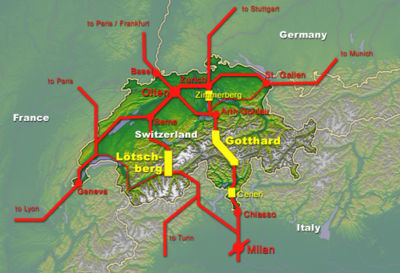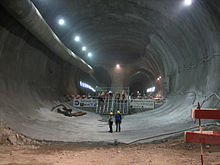- AlpTransit
-
AlpTransit, also known as New Railway Link through the Alps NRLA (German: Neue Eisenbahn-Alpentransversale, NEAT), is a Swiss federal project aimed to build faster north-south rail links across the Swiss Alps by constructing base tunnels several hundred metres below the level of the current tunnels. For safety reasons, all the tunnels were planned to consist of two single-track bores side by side that are connected about every 300 metres with cross cuts, enabling the other tunnel to be used for escape.
The project comprises two major sections, the Gotthard axis and the Lötschberg axis.
Contents
Gotthard axis
The Gotthard axis, with the new base tunnels at Gotthard, Zimmerberg and Ceneri is being built under contract from the Swiss Federal Government by the company AlpTransit Gotthard AG. With a planned length of 57 km (35 miles), the Gotthard Base Tunnel is the longest railway tunnel in the world. As of August 2011[update], the tunnel is due to open in December 2016.[1] This updates previous estimate of 2018, according to a 2007 investigation for the Télévision Suisse Romande programme Temps Présent[2]), as the original Gotthard tunnel of 15 km (9.3 mi) was at the time of its completion in 1881. The new Gotthard rail link, consisting of the Zimmerberg Base Tunnel, Gotthard Base Tunnel and Ceneri Base Tunnel, is designed to become the first flat transalpine rail link with a maximum elevation of just 550 m above sea level. This results in a high speed link through the Alps with a top speed estimated at 250 km/h, reducing travel time between Zurich and Milan to 2h30 instead of 4h00 currently.[3][4][5]
Lötschberg axis
The Lötschberg axis, with the new Lötschberg Base Tunnel in the Bernese Alps was constructed by the company BLS AlpTransit Lötschberg AG. The 34.6 km (21.5 mi) long base tunnel opened to traffic in June 2007 and is the first part of AlpTransit to be completed. It supports the western transit link via Basel - Olten - Bern - Brig - Domodossola - Milan. For most traffic, it will replace the existing higher altitude 14.6 km (9.1 mi) Lötschberg Tunnel that was finished in 1913. Because of cost constraints, only one of the bores of the Lötschberg Tunnel has been completed and equipped for rail use, while the other, was completed along one third of its length and excavated along a further third leaving the final third unstarted. High speed track switches allow the use of the completed third as a passing track. The second part of the Lötschberg axis is the ancient Simplon Tunnel, completed in 1905 as a 20 km (12 mi) long single-track base tunnel and augmented with a second bore by the end of 1921. It connects the Upper Valais with the Piedmont region in Northern Italy.
Political background
In negotiations with the European Union, Switzerland demanded a limitation of transalpine heavy goods traffic which was denied by the EU. Therefore the Swiss negotiators took another route and demanded a kilometre-based tax on heavy goods vehicles, the so called LSVA, which was to be installed for all domestic and international truck traffic above 3.5 tonnes. Negotiations subsequently turned towards the amount of that tax, and Switzerland offered to build a new high-speed rail link through the Alps for the main purpose of intermodal transport, an offer which was later accepted by the EU but not without attaching the condition that the then valid 28-tonne limit for trucks must be raised to 48 tonnes. A settlement was achieved with the acceptance by both sides of a step-by-step raise of the weight limit to 40 tonnes. Thus, the bilateral Land Transport Agreement with the European Union was reached and once the NRLA is finished, the kilometre-based tax on HGVs can be increased from 1.6 ct/tkm to 1.8 ct/tkm. This condition will be fulfilled with the completion of the Lötschberg base tunnel.
Further Swiss legislation demands a stop of road building in the Alps and a shift in transportation policy (Article on the Protection of the Alps, adopted 1994), the transfer of as many goods as possible from transalpine transport by road to transport by train and the setting of a Transfer Goal, a maximum number of trucks to cross the Alps by road (Traffic Transfer Act, adopted 1999). These goals however can only be accomplished with a fully functional Alptransit rail link.
Original plans for the NRLA included the construction of only one of the main base tunnels. Since no decision could be made and regional dispute threatened to put the entire project in danger, the Swiss Federal Council decided in 1996 to build both base tunnels, Gotthard and Lötschberg, and to build them simultaneously.
The total cost of the AlpTransit projects is currently (2005) estimated to reach 16 billion Swiss francs (13 billion US dollars). The Swiss population accepted the project by vote on September 27, 1992 and re-approved it, accepting its new financing structure by a new public transport fund, in 1999. This fund (German: FinöV) is fed mainly by a kilometre-based tax on heavy goods vehicles, as well as part of the taxes on gasoline originally intended for road building and a minor part of VAT funds. The fund amounts to CHF 30.5 billion (ca. $33.9 billion) allocated over 20 years and funds projects other than AlpTransit, such as Rail 2000.
See also
References
- ^ Gotthard Base Tunnel to be operational from 2016 , 25 Aug 2011 AlpTransit
- ^ "Temps Présent", May 24, 2007.
- ^ Gotthard: A titanic tunnel AllBusiness, 29 April 2010. Retrieved: 17 September 2010.
- ^ Tunnel technology for the future Leica. Retrieved: 17 September 2010.
- ^ Shafy, Samiha. Elevator to the Underworld Der Spiegel, 31 December 2006. Retrieved: 17 September 2010.
External links
- (English)(German)(French)(Italian) AlpTransit.ch – The official website
- (English) NRLA factsheet from the Swiss Ministry of Environment and Transportation UVEK
- (English) Dossier 'Alptransit' at swisspolitics.org
- (English) Alpine-Initiative site with political background information
- (English) BBC News site
Categories:- Rail transport in Switzerland
- Tunnels in Switzerland
- Railway tunnels in Switzerland
- International tunnels
- International railway lines
Wikimedia Foundation. 2010.



